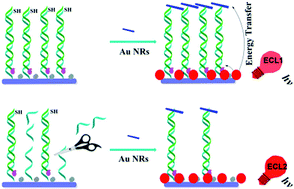当前位置:
X-MOL 学术
›
Anal. Methods
›
论文详情
Our official English website, www.x-mol.net, welcomes your feedback! (Note: you will need to create a separate account there.)
Dual-quenching strategy for determination of ATP based on aptamer and exonuclease I-assisted electrochemiluminescence resonance energy transfer
Analytical Methods ( IF 3.1 ) Pub Date : 2018-04-24 00:00:00 , DOI: 10.1039/c8ay00465j Heng-Yu Xu 1, 2, 3, 4, 5 , Long-Sheng Jin 1, 2, 3, 4, 5 , Ning Xu 1, 2, 3, 4, 5 , Jing-Ru Chen 1, 2, 3, 4, 5 , Mei-Sheng Wu 1, 2, 3, 4, 5
Analytical Methods ( IF 3.1 ) Pub Date : 2018-04-24 00:00:00 , DOI: 10.1039/c8ay00465j Heng-Yu Xu 1, 2, 3, 4, 5 , Long-Sheng Jin 1, 2, 3, 4, 5 , Ning Xu 1, 2, 3, 4, 5 , Jing-Ru Chen 1, 2, 3, 4, 5 , Mei-Sheng Wu 1, 2, 3, 4, 5
Affiliation

|
We report a dual-quenching strategy for highly sensitive detection of adenosine triphosphate (ATP) using electrochemiluminescence (ECL) recovery based on the exonuclease-assisted reduction in amounts of both ferrocene and ECL-RET acceptor (Au nanorod). Ru(bpy)32+ was used as the ECL donor due to its high quantum yield and high ECL intensity. First, ATP aptamer labeled with ferrocene (Fc) was introduced onto the electrode surface through the hybridization of the aptamer with capture DNA. Moreover, the 3′ terminus of the capture DNA had been designed to be modified with a thiol group. In the absence of ATP, the capture DNA could not be digested by exonuclease I (Exo I), resulting in a decreased background ECL signal. Additionally, a large amount of Au nanorods was conjugated at the 3′-terminus of capture DNA through Au–S bonds, leading to further reduction of the background ECL signal due to the ECL resonance energy transfer (ECL-RET) between Ru(bpy)32+ and Au nanorods. However, in the presence of ATP, the ECL signal could be enhanced significantly not only because of the liberation of the Fc-aptamer from the electrode surface, but also due to the reduced concentration of Au nanorods after the cleavage of single-stranded capture DNA in the 3′ to 5′ direction with Exo I. This method provides a simple and sensitive approach for ATP detection and holds great potential in cancer-biomarker assays.
中文翻译:

基于适体和核酸外切酶I辅助电化学发光共振能量转移的ATP双猝灭策略
我们报告了双猝灭策略,用于基于电化学发光(ECL)恢复的高灵敏度检测三磷酸腺苷(ATP),该恢复基于核酸外切酶辅助的二茂铁和ECL-RET受体(Au纳米棒)的减少量。Ru(bpy)3 2+由于其高量子产率和高ECL强度,其被用作ECL供体。首先,通过将二茂铁(Fc)标记的ATP适体通过适体与捕获DNA的杂交引入到电极表面上。此外,捕获DNA的3'末端已被设计为用巯基修饰。在没有ATP的情况下,捕获的DNA无法被核酸外切酶I(Exo I)消化,从而导致背景ECL信号降低。此外,大量的金纳米棒通过Au–S键结合在捕获DNA的3'末端,由于Ru(bpy)之间的ECL共振能量转移(ECL-RET),导致背景ECL信号进一步降低。 )3 2+和金纳米棒。然而,在存在ATP的情况下,ECL信号可以显着增强,这不仅是因为Fc适体从电极表面释放出来,而且还因为单链捕获DNA裂解后Au纳米棒的浓度降低了。用Exo I在3'到5'方向进行分析。该方法提供了一种简单而灵敏的ATP检测方法,在癌症生物标志物检测中具有巨大的潜力。
更新日期:2018-04-24
中文翻译:

基于适体和核酸外切酶I辅助电化学发光共振能量转移的ATP双猝灭策略
我们报告了双猝灭策略,用于基于电化学发光(ECL)恢复的高灵敏度检测三磷酸腺苷(ATP),该恢复基于核酸外切酶辅助的二茂铁和ECL-RET受体(Au纳米棒)的减少量。Ru(bpy)3 2+由于其高量子产率和高ECL强度,其被用作ECL供体。首先,通过将二茂铁(Fc)标记的ATP适体通过适体与捕获DNA的杂交引入到电极表面上。此外,捕获DNA的3'末端已被设计为用巯基修饰。在没有ATP的情况下,捕获的DNA无法被核酸外切酶I(Exo I)消化,从而导致背景ECL信号降低。此外,大量的金纳米棒通过Au–S键结合在捕获DNA的3'末端,由于Ru(bpy)之间的ECL共振能量转移(ECL-RET),导致背景ECL信号进一步降低。 )3 2+和金纳米棒。然而,在存在ATP的情况下,ECL信号可以显着增强,这不仅是因为Fc适体从电极表面释放出来,而且还因为单链捕获DNA裂解后Au纳米棒的浓度降低了。用Exo I在3'到5'方向进行分析。该方法提供了一种简单而灵敏的ATP检测方法,在癌症生物标志物检测中具有巨大的潜力。


























 京公网安备 11010802027423号
京公网安备 11010802027423号